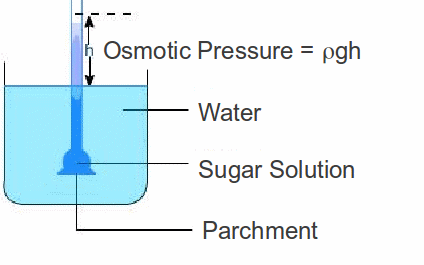Before cooking dried fruits – prunes and apricots – it is customary to leave them soaking in cold water so that they absorb water and swell. During the soaking, water passes through the skin of the fruit and the cell walls by a process called osmosis.
Osmosis is easily demonstrated. A narrow glass tube ending in a large bulb opening has this opening covered with parchment (a semi permeable membrane, allowing water molecules to pass through, but not the larger sugar molecules), watertight around the edges. The funnel is filled with a sugar solution and placed upside down in a beaker of water.
This means that the rate of passage of molecules from the water side iis greater than the rate of passage of molecules from the sugar solution side. The liquid level in the tube begins to rise, showing that water is passing through the parchment into the sugar solution. Eventually the level will stop rising. If the difference between the height of water in the tube and beaker is h, then the osmotic pressure is given by![]()

The skin and cell walls of prunes are a semi permeable membrane in the same way. The cells are full of sugars, and the cell walls allow water to pass into the cell but not sugars to pass out. Consequently, the cells begin to fill with water and become plump.
Most animal and plant cells are semi permeable and osmosis plays an important part in maintaining the correct concentration of water, by absorbing water into cells and ridding the body of waste products. Artificial kidneys use semi permeable membranes (cellophane! Is one such) in the same way, placed between an artery and a vein, to clean the blood if the kidneys are not properly functioning through disease or illness.
